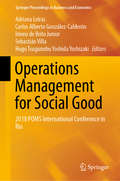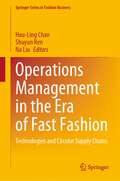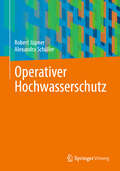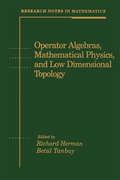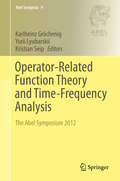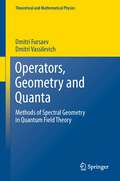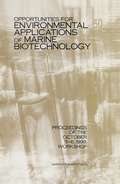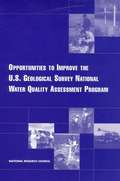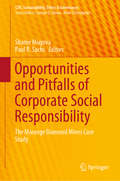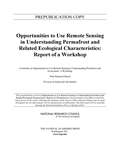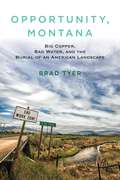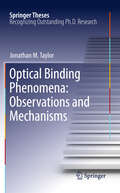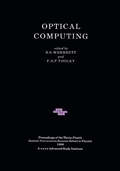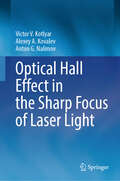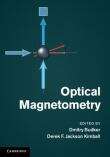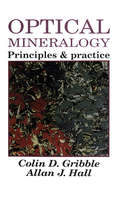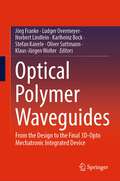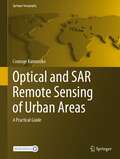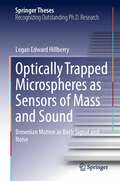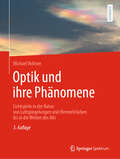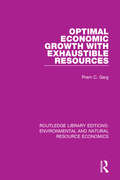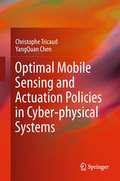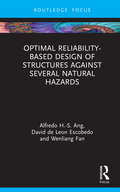- Table View
- List View
Operations Management for Social Good: 2018 POMS International Conference in Rio (Springer Proceedings in Business and Economics)
by Sebastián Villa Adriana Leiras Carlos Alberto González-Calderón Irineu de Brito Junior Hugo Tsugunobu Yoshida YoshizakiThis volume showcases the presentations and discussions delivered at the 2018 POMS International Conference in Rio. Through a collection of selected papers, it is possible to review the impact and application of operations management for social good, with contributions across a wide range of topics, including: humanitarian operations and crisis management, healthcare operations management, sustainable operations, artificial intelligence and data analytics in operations, product innovation and technology in operations management, marketing and operations management, service operations and servitization, logistics and supply chain management, resilience and risk in operations, defense, and tourism among other emerging Operations Management issues. The Production and Operations Management Society (POMS) is one of the most important and influential societies in the subject of Production Engineering and, as an international professional and academic organization, represents the interests of professionals and academics in production management and operations around the world.
Operations Management in the Era of Fast Fashion: Technologies and Circular Supply Chains (Springer Series in Fashion Business)
by Na Liu Hau-Ling Chan Shuyun RenThis book reports the latest business practices, operations models, technologies and circular supply chain structure of the fast fashion companies and provides many important managerial insights on the sustainable operations management in the fast fashion era. Sustainability is a timely topic in both the academia and the business world. In the fast fashion era, there are considerable criticisms about its environmental pollution generated in the manufacturing and post-consumption processes. Over the past decades, many fast fashion companies, such as H&M, Zara, and Uniqlo, have implemented different sustainable programs to mitigate the negative impacts to the environment. Nowadays, the industry is moving one step further by addressing zero landfill through 3Rs principle (i.e., reducing, reusing and recycling), and pursuit of the circular supply chains. This book aims to reveal the exploratory, qualitative empirical and quantitative analytical studies on how to achieve the goal of being environmentally sustainable in the fast fashion era.
Operativer Hochwasserschutz
by Robert Jüpner Alexandra SchüllerDie Bewältigung von Hochwasserereignissen ist Teil des gesamtgesellschaftlichen Umgangs mit Naturkatastrophen. Die interdisziplinäre Vernetzung einzelner Fragestellungen sowie die Verschneidung der Perspektiven verschiedener Akteure bietet großes Potenzial im Bereich Hochwasserschutz. Die gewählte Struktur des vorliegenden Buches ist bewusst für einen breiten Leserkreis ausgerichtet, um diese verschiedenen Akteure mit unterschiedlichen fachlichen Hintergründen erreichen zu können. Für eine erfolgreiche und effektive Hochwasserbewältigung ist eine intensive Vorbereitung auf verschiedene Hochwasserszenarien erforderlich. Dies beinhaltet auch eine fundierte Ereignisanalyse nach Ablauf eines Hochwassers. Auch wenn jedes Hochwasserereignis eine besondere Ausprägung besitzt und von einer Vielzahl meteorologischer, hydrologischer, räumlicher und nicht zuletzt gesellschaftspolitischer Rahmenbedingungen abhängig ist, lassen sich grundlegende Erkenntnisse aus den jeweiligen Hochwasserbewältigungsstrategien und -maßnahmen ableiten.
Operator Algebras, Mathematical Physics, and Low Dimensional Topology (Research Notes in Mathematics)
by Richard Herman Betiil TanbayThis volume records the proceedings of an international conference that explored recent developments and the interaction between mathematical theory and physical phenomena.
Operator-Related Function Theory and Time-Frequency Analysis
by Karlheinz Gröchenig Yurii Lyubarskii Kristian SeipThis book collects the proceedings of the 2012 Abel Symposium, held at the Norwegian Academy of Science and Letters, Oslo. The Symposium, and this book, are focused on two important fields of modern mathematical analysis: operator-related function theory and time-frequency analysis; and the profound interplay between them. Among the original contributions and overview lectures gathered here are a paper presenting multifractal analysis as a bridge between geometric measure theory and signal processing; local and global geometry of Prony systems and Fourier reconstruction of piecewise-smooth functions; Bernstein's problem on weighted polynomial approximation; singular distributions and symmetry of the spectrum; and many others. Offering a selection of the latest and most exciting results obtained by world-leading researchers, the book will benefit scientists working in Harmonic and Complex Analysis, Mathematical Physics and Signal Processing.
Operators, Geometry and Quanta
by Dmitri Fursaev Dmitri VassilevichThis book gives a detailed and self-contained introduction into the theory of spectral functions, with an emphasis on their applications to quantum field theory. All methods are illustrated with applications to specific physical problems from the forefront of current research, such as finite-temperature field theory, D-branes, quantum solitons and noncommutativity. In the first part of the book, necessary background information on differential geometry and quantization, including less standard material, is collected. The second part of the book contains a detailed description of main spectral functions and methods of their calculation. In the third part, the theory is applied to several examples (D-branes, quantum solitons, anomalies, noncommutativity). This book addresses advanced graduate students and researchers in mathematical physics with basic knowledge of quantum field theory and differential geometry. The aim is to prepare readers to use spectral functions in their own research, in particular in relation to heat kernels and zeta functions.
Opinions About Ocean Health
by Jeffrey B. Fuerst Andy SloanEarth's oceans are home to 80% of the life-forms on the planet and are a vital part of Earth's food chain. Unfortunately, climate change, pollution, and overfishing are damaging the oceans. Read about these threats to ocean health, then read three writers' opinions about which of those threats is the greatest.
Opportunities For Environmental Applications Of Marine Biotechnology: Proceedings Of The October 5-6, 1999, Workshop
by Board On BiologyInformation on the Opportunities For Environmental Applications Of Marine Biotechnology
Opportunities To Improve The U.s. Geological Survey National Water Quality Assessment Program
by Committee to Improve the U.S. Geological Survey National Water Quality Assessment ProgramThe U.S. Geological Survey (USGS) established the National Water Quality Assesment (NAWQA) program in 1985 to assess water quality conditions and trends in representative river basins and aquifers across the United States. With this report, the NRC's Water Science and Technology Board has provided advice to USGS regarding NAWQA five separate times as the program evolved from an unfunded concept to a mature and nationally--recognized program in 2002. This report assesses the program's development and representative accomplishments to date and makes recommendations on opportunities to improve NAWQA as it begins its second decade of nationwide monitoring.
Opportunities and Pitfalls of Corporate Social Responsibility: The Marange Diamond Mines Case Study (CSR, Sustainability, Ethics & Governance)
by Shame Mugova Paul R. SachsThis book addresses key aspects of corporate social responsibility (CSR) and explores them from a variety of perspectives in a case study on the Marange diamond mines in Zimbabwe. The business case of the Marange mines is presented to demonstrate the challenge of practicing social responsibility while considering and balancing the needs of a developing nation, environmental protection, community involvement and international business. Lessons learned from the case study will help business leaders and strategists in developing countries and multinational corporations to better understand and employ CSR principles so as to enhance sustainability and social impact. Further, the book provides a unique combination of academic, industrial and local approaches.
Opportunities to Use Remote Sensing in Understanding Permafrost and Related Ecological Characteristics: Report of a Workshop
by Committee on Opportunities to Use Remote Sensing in Understanding Permafrost Ecosystems: A WorkshopPermafrost is a thermal condition -- its formation, persistence and disappearance are highly dependent on climate. General circulation models predict that, for a doubling of atmospheric concentrations of carbon dioxide, mean annual air temperatures may rise up to several degrees over much of the Arctic. In the discontinuous permafrost region, where ground temperatures are within 1-2 degrees of thawing, permafrost will likely ultimately disappear as a result of ground thermal changes associated with global climate warming. Where ground ice contents are high, permafrost degradation will have associated physical impacts. Permafrost thaw stands to have wide-ranging impacts, such as the draining and drying of the tundra, erosion of riverbanks and coastline, and destabilization of infrastructure (roads, airports, buildings, etc. ), and including potential implications for ecosystems and the carbon cycle in the high latitudes. "Opportunities to Use Remote Sensing in Understanding Permafrost and Related Ecological Characteristics" is the summary of a workshop convened by the National Research Council to explore opportunities for using remote sensing to advance our understanding of permafrost status and trends and the impacts of permafrost change, especially on ecosystems and the carbon cycle in the high latitudes. The workshop brought together experts from the remote sensing community with permafrost and ecosystem scientists. The workshop discussions articulated gaps in current understanding and potential opportunities to harness remote sensing techniques to better understand permafrost, permafrost change, and implications for ecosystems in permafrost areas. This report addresses questions such as how remote sensing might be used in innovative ways, how it might enhance our ability to document long-term trends, and whether it is possible to integrate remote sensing products with the ground-based observations and assimilate them into advanced Arctic system models. Additionally, the report considers the expectations of the quality and spatial and temporal resolution possible through such approaches, and the prototype sensors that are available that could be used for detailed ground calibration of permafrost/high latitude carbon cycle studies.
Opportunity, Montana: Big Copper, Bad Water, and the Burial of an American Landscape
by Brad TyerA memoir-meets-exposé that examines our fraught relationship with the West and our attempts to clean up a toxic environmental legacy In 2002, Texas journalist Brad Tyer strapped a canoe on his truck and moved to Montana, a state that has long exerted a mythic pull on America's imagination as an unspoiled landscape. The son of an engineer who reclaimed wastewater, Tyer was looking for a pristine river to call his own. What he found instead was a century's worth of industrial poison clotting the Clark Fork River, a decades-long engineering project to clean it up, and a forgotten town named Opportunity. At the turn of the nineteenth century, Montana exploited the richest copper deposits in the world, fueling the electric growth of twentieth-century America and building some of the nation's most outlandish fortunes. The toxic by-product of those fortunes--what didn't spill into the river--was dumped in Opportunity. In the twenty-first century, Montana's draw is no longer metal but landscape: the blue-ribbon trout streams and unspoiled wilderness of the nation's "last best place." To match reality to the myth, affluent exurbanites and well-meaning environmentalists are trying to restore the Clark Fork River to its "natural state." In the process, millions of tons of toxic soils are being removed and dumped--once again--in Opportunity. As Tyer investigates Opportunity's history, he wrestles with questions of environmental justice and the ethics of burdening one community with an entire region's waste. Stalled at the intersection of a fading extractive economy and a fledgling restoration boom, Opportunity's story is a secret history of the American Dream and a key to understanding the country's--and increasingly the globe's--demand for modern convenience. As Tyer explores the degradations of the landscape, he also probes the parallel emotional geography of familial estrangement. Part personal history and part reportorial narrative, Opportunity, Montana is a story of progress and its price: of copper and water, of father and son, and of our attempts to redeem the mistakes of the past. From the Hardcover edition.
Optical Binding Phenomena: Observations and Mechanisms
by Jonathan M. TaylorThis thesis addresses optical binding - a new area of interest within the field of optical micromanipulation. It presents, for the first time, a rigorous numerical simulation of some of the key results, along with new experimental findings and also physical interpretations of the results. In an optical trap particles are attracted close to areas of high optical intensities and intensity gradients. So, for example, if two lasers are pointed towards each other (a counter propagating trap) then a single particle is trapped in the centre of the two beams - the system is analogous to a particle being held by two springs in a potential well. If one increases the number of particles in the trap then naively one would expect all the particles to collect in the centre of the well. However, the effect of optical binding means that the presence of one particle affects the distribution of light experienced by another particle, resulting in extremely complex interactions that can lead to unusual 1D and 2D structures to form within the trap. Optical binding is not only of theoretical interest but also has applications in micromanipulation and assembly.
Optical Computing (Scottish Graduate Ser. #34)
by B.S. Wherrett; F.A.P. TooleyWritten by ten leading experts in the field, Optical Computing cover topics such as optical bistability, optical interconnects and circuits, photorefractive devices, spatial light modulators, associative memory, and optical computer architectures.
Optical Hall Effect in the Sharp Focus of Laser Light
by Victor V. Kotlyar Alexey A. Kovalev Anton G. NalimovThis book explores the optical Hall effect in the sharp focus of laser light. It builds upon the established theory of Richards-Wolf (1959), providing numerous real-world examples that illustrate both spin and orbital Hall effects near the focal point. Within the focal zone, distinct regions of left and right circular polarization emerge, showcasing the orbital Hall effect. This effect becomes apparent when localized areas within the focal plane experience transverse energy flow, rotating either clockwise or counterclockwise. The spin Hall effect, a fundamental occurrence, is demonstrated when a linearly polarized Gaussian beam is concentrated. Furthermore, the book reveals spin and orbital Hall effects in light fields with nonuniform linear polarization, where the polarization direction varies within the beam cross section. While the optical or photonic Hall effect has been recognized since 2004, a comprehensive monograph detailing its focal dynamics has been lacking until now. Drawing from the cohesive theoretical framework of the Richards-Wolf theory, this book offers specific examples and results from computer modeling. It equips readers with analytical relations for calculating energy and spin fluxes near a sharp focus across various initial light vector fields. Designed for a diverse audience, including scientists, engineers, and students in optics and photonics, this book serves as a valuable resource. It caters to undergraduate and graduate students in applied mathematics, physics, informatics, and optics, and can also benefit researchers and professionals in the field. Moreover, the book holds potential as a foundational text for advanced graduate courses
Optical Magnetometry
by Dmitry Budker Derek F. Jackson KimballFeaturing chapters written by leading experts in magnetometry, this book provides comprehensive coverage of the principles, technology and diverse applications of optical magnetometry, from testing fundamental laws of nature to detecting biomagnetic fields and medical diagnostics. Readers will find a wealth of technical information, from antirelaxation-coating techniques, microfabrication and magnetic shielding to geomagnetic-field measurements, space magnetometry, detection of biomagnetic fields, detection of NMR and MRI signals and rotation sensing. The book includes an original survey of the history of optical magnetometry and a chapter on the commercial use of these technologies. The book is supported by extensive online material, containing historical overviews, derivations, sideline discussion, additional plots and tables, available at www. cambridge. org/9781107010352. As well as introducing graduate students to this field, the book is also a useful reference for researchers in atomic physics.
Optical Mineralogy: Principles And Practice
by Colin D GribbleCovering theory and practice, this wide-ranging introductory textbook covers the main optical properties of rock-forming minerals that can be recognized under the polarizing microscope. The authors elucidate the basic elements of microscopy, the theory of light transmission through translucent minerals, and the properties of light reflected from op
Optical Polymer Waveguides: From the Design to the Final 3D-Opto Mechatronic Integrated Device
by Stefan Kaierle Jörg Franke Ludger Overmeyer Klaus-Jürgen Wolter Norbert Lindlein Karlheinz Bock Oliver SuttmannLight signals in optical waveguides can be used to transmit very large amounts of data quickly and largely without interference. In the industrial and infrastructural sectors, e.g. in the automotive and aerospace industries, the demand to further exploit this potential is therefore increasing. Which technologies can be used to effectively integrate systems that transmit data by means of light into existing components? This is a central question for current research. So far, there have been some technical limitations in this regard. For example, it is difficult to couple the signal of an optical waveguide to other optical waveguides without interruption. There is also a lack of suitable fabrication technologies for three-dimensional waveguides, as well as design and simulation environments for 3D opto-MID. This book addresses these and other challenges.
Optical and SAR Remote Sensing of Urban Areas: A Practical Guide (Springer Geography)
by Courage KamusokoThis book introduces remotely sensed image processing for urban areas using optical and synthetic aperture radar (SAR) data and assists students, researchers, and remote sensing practitioners who are interested in land cover mapping using such data. There are many introductory and advanced books on optical and SAR remote sensing image processing, but most of them do not serve as good practical guides. However, this book is designed as a practical guide and a hands-on workbook, where users can explore data and methods to improve their land cover mapping skills for urban areas. Although there are many freely available earth observation data, the focus is on land cover mapping using Sentinel-1 C-band SAR and Sentinel-2 data. All remotely sensed image processing and classification procedures are based on open-source software applications such QGIS and R as well as cloud-based platforms such as Google Earth Engine (GEE). The book is organized into six chapters. Chapter 1 introduces geospatial machine learning, and Chapter 2 covers exploratory image analysis and transformation. Chapters 3 and 4 focus on mapping urban land cover using multi-seasonal Sentinel-2 imagery and multi-seasonal Sentinel-1 imagery, respectively. Chapter 5 discusses mapping urban land cover using multi-seasonal Sentinel-1 and Sentinel-2 imagery as well as other derived data such as spectral and texture indices. Chapter 6 concludes the book with land cover classification accuracy assessment.
Optically Trapped Microspheres as Sensors of Mass and Sound: Brownian Motion as Both Signal and Noise (Springer Theses)
by Logan Edward HillberryThis thesis makes significant advances in the use of microspheres in optical traps as highly precise sensing platforms. While optically trapped microspheres have recently proven their dominance in aqueous and vacuum environments, achieving state-of-the-art measurements of miniscule forces and torques, their sensitivity to perturbations in air has remained relatively unexplored. This thesis shows that, by uniquely operating in air and measuring its thermally-fluctuating instantaneous velocity, an optically trapped microsphere is an ultra-sensitive probe of both mass and sound. The mass of the microsphere is determined with similar accuracy to competitive methods but in a fraction of the measurement time and all while maintaining thermal equilibrium, unlike alternative methods. As an acoustic transducer, the air-based microsphere is uniquely sensitive to the velocity of sound, as opposed to the pressure measured by a traditional microphone. By comparison to state-of-the-art commercially-available velocity and pressure sensors, including the world’s smallest measurement microphone, the microsphere sensing modality is shown to be both accurate and to have superior sensitivity at high frequencies. Applications for such high-frequency acoustic sensing include dosage monitoring in proton therapy for cancer and event discrimination in bubble chamber searches for dark matter. In addition to reporting these scientific results, the thesis is pedagogically organized to present the relevant history, theory, and technology in a straightforward way.
Optik und ihre Phänomene: Lichtspiele in der Natur: von Luftspiegelungen und Himmelsfarben bis in die Weiten des Alls
by Michael VollmerDieses Lehr-, Lern-, Fach- und Sachbuch präsentiert die Grundlagen der Optik in Theorie und ausführlich beschriebenem Experiment sowie vielfältige faszinierende optische Phänomene. Ob in Vorlesungen, Seminaren, für Projektarbeiten, Schulunterricht oder Selbststudium - dieses Buch ist eine wertvolle Ressource für alle, die sich für Optik interessieren. Durch die große Zahl zitierter Originalarbeiten schlägt es nicht nur die Brücke zur Lehre sondern auch zur Forschung. Besonderheiten: Das Buch besticht durch seine über 1000 Abbildungen, darunter über 200 qualitativ hochwertige Farbfotos optischer Naturphänomene sowie einer großen Zahl an wissenschaftlichen und physikdidaktischen Literaturangaben für weiterführende Studien. Die Kapitel sind jeweils auch einzeln lesbar, aber zusammen ist es eine einmalige Kombination aus einführendem Lehrbuch der klassischen Optik und detaillierter up-to-date Zusammenstellung von Anwendungen im Bereich optischer Naturphänomene. Thematisch spannt es einen sehr weiten Bogen: von geometrischer, Wellen- und Quantenoptik, Radiometrie und Photometrie über Farbtheorien und technische Anwendungen wie Spektroskopie bis hin zu Naturphänomenen oder der Frage warum der Himmel nachts dunkel ist. Die Grundlagen werden vertieft durch zahlreiche Verständnisfragen und Übungsaufgaben zusätzlich zu vielen Anwendungsbeispielen, die von Fensterreflexionen über Lichtwellenleiter und Smartphoneobjektive bis hin zu modernen Beamern reichen. Inhalt: 1. Einleitung .- 2. Geometrische Optik .- 3. Wellenoptik .- 4. Wechselwirkung von Strahlung mit Materie: Quantenoptik .- 5. Detektoren und Lichtquellen .- 6. Visuelle Wahrnehmung .- 7. Die Atmosphäre der Erde .- 8. Luftspiegelungen.- 9. Regenbögen .- 10. Koronen, Glorien und verwandte Erscheinungen .- 11. Haloerscheinungen am Himmel.- 12. Lichtstreuung und Himmelsfarben .- 13. Weitere Phänomene aufgrund von Lichtstreuung .- 14. Bis in die Stratosphäre und darüber hinaus Neuerungen (zur 2.Aufl.): Der erste Lehrbuchteil zu den Grundlagen ist komplett neu hinzugefügt. Der zweite Teil zu den Anwendungen und Naturphänomenen wurde komplett überarbeitet und aktualisiert. Zudem illustrieren nun über 200 Farbfotos die Phänomene. Die Zielgruppe: Sowohl interessierte Laien - mit und ohne Vorwissen - und Lehrkräfte an Schulen als auch Studierende diverser Fachrichtungen sowie deren Lehrende profitieren von dieser umfangreichen Zusammenstellung. Optik wird nicht nur im Bachelor bzw. Master in Physik u. Astronomie bzw. Astrophysik sowie in den Naturwissenschaften thematisiert, sondern auch in Studiengängen mit Schwerpunkten wie Licht- und Beleuchtungstechnik, Lasertechnik, optische Technologien, Optoelektronik und Photonik, Augenoptik, Meteorologie, uvm. Vorkenntnisse: Erforderlich ist kein besonderes Vorwissen, allerdings ermöglichen manche der angegebenen Querbezüge ein tieferes Verständnis, welches sich erst mit Vorkenntnissen aus einigen Grundlagenfächern der Physik, insbesondere des Elektromagnetismus, der Festkörperphysik sowie der Quantenphysik vollständig erschließt.
Optimal Control of Age-structured Populations in Economy, Demography, and the Environment (Routledge Explorations In Environmental Economics Ser. #29)
by Natali Hritonenko Yuri Yatsenko Raouf BoucekkineThis book covers a wide range of topics within mathematical modelling and the optimization of economic, demographic, technological and environmental phenomena. Each chapter is written by experts in their field and represents new advances in modelling theory and practice. These essays are exemplary of the fruitful interaction between theory and practice when exploring global and local changes. The unifying theme of the book is the use of mathematical models and optimization methods to describe age-structured populations in economy, demography, technological change, and the environment. Emphasis is placed on deterministic dynamic models that take age or size structures, delay effects, and non-standard decision variables into account. In addition, the contributions deal with the age structure of assets, resources, and populations under study. Interdisciplinary modelling has enormous potential for discovering new insights in global and regional development. Optimal Control of Age-structured Populations in Economy, Demography, and the Environment is a rich and excellent source of information on state-of-the-art modelling expertise and references. The book provides the necessary mathematical background for readers from different areas, such as applied sciences, management sciences and operations research, which helps guide the development of practical models. As well as this the book also surveys the current practice in applied modelling and looks at new research areas for a general mathematical audience. This book will be of interest primarily to researchers, postgraduate students, as well as a wider scientific community, including those focussing on the subjects of applied mathematics, environmental sciences, economics, demography, management, and operations research.
Optimal Economic Growth with Exhaustible Resources (Routledge Library Editions: Environmental and Natural Resource Economics)
by Prem C. GargOriginally published in 1979. For decades conservationists have argued that increasing population will eventually out-strip the limited natural resources of the earth. Economists have responded by saying that any resource scarcity will be forestalled by changes in tastes and technology, induced by the appropriate price signals. This study is an attempt to develop a theoretical framework for analysing some of the issues related to this debate. Using an optimal growth theory framework, the author analyses the problem of optimally allocating a finite stock of the resource over time. In the process the author points out the crucial parameters and value judgments relevant to the various issues. This title will be of interest to students of environmental economics.
Optimal Mobile Sensing and Actuation Policies in Cyber-physical Systems
by Yangquan Chen Christophe TricaudA successful cyber-physical system, a complex interweaving of hardware and software with some part of the physical environment, depends on proper identification of the, often pre-existing, physical element. A bespoke "cyber" part of the system may then be designed from scratch. Optimal Mobile Sensing and Actuation Strategies in Cyber-physical Systems focuses on distributed-parameter systems the dynamics of which can be modelled with partial differential equations. These are very challenging to observe, their states and inputs being distributed throughout a spatial domain. Consequently, systematic approaches to the optimization of sensor location have to be devised for parameter estimation. The text begins by reviewing the field of cyber-physical systems and introducing background notions of distributed parameter systems and optimal observation theory. New research problems are then defined within this framework. Two important problems considered are optimal mobile sensor trajectory planning and the accuracy effects and allocation of remote sensors. These are followed up with a solution to the problem of optimal robust estimation. Actuation policies are then introduced into the framework with the purpose of improving estimation and optimizing the trajectories of both sensors and actuators simultaneously. The large number of illustrations within the text will assist the reader to visualize the application of the methods proposed. A group of similar examples are used throughout the book to help the reader assimilate the material more easily. The monograph concentrates on the use of methods for which a cyber-physical-systems infrastructure is required. The methods are computationally heavy and require mobile sensors and actuators with communications abilities. Application examples cover fields from environmental science to national security so that readers are encouraged to link the ideas of cyber-physical systems with their own research.
Optimal Reliability-Based Design of Structures Against Several Natural Hazards
by Alfredo H-S Ang David de Escobedo Wenliang FanInterest in the topic of structural reliability and optimal design has been rapidly growing in recent years. Besides, the field of numerical methods and artificial intelligence is experiencing a surge of new methods and the refinement of existing ones to expand opportunities to apply robust formulations to complex engineering problems. Today, more than ever, the field is receiving fresh ideas on how to face the challenges of finding a balance between cost and benefits that may lead towards the optimal design of systems. Recently, the probability density evolution method (PDEM) was proposed by Prof. Jie Li as an alternative way to obtain the stochastic and dynamic solution of the safety level of engineering systems under any kind of hazard. This work deals with the application of this powerful method to derive optimal design recommendations for large engineering systems under natural hazards. The three case studies illustrate to engineers and academic specialists how to strike a cost-effective balance in designing such systems.
